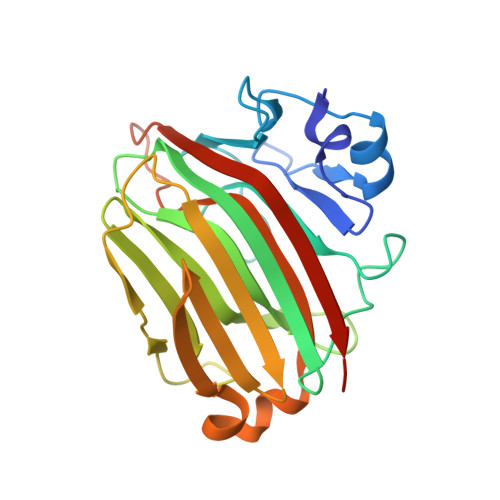A Structural Basis for Depolymerization of Alginate by Polysaccharide Lyase Family-7
Yamasaki, M., Ogura, K., Hashimoto, W., Mikami, B., Murata, K.(2005) J Mol Biol 352: 11-21
- PubMed: 16081095
- DOI: https://doi.org/10.1016/j.jmb.2005.06.075
- Primary Citation of Related Structures:
2CWS - PubMed Abstract:
Alginate lyases depolymerize alginate, a heteropolysaccharide consisting of alpha-L-guluronate and beta-D-mannuronate, through a beta-elimination reaction. Their structure/function relationships are expected to provide information valuable to future industrial alginate processing and drug design for Pseudomonas aeruginosa alginate biofilm-dependent infection, but much remains unknown. Here, we present the crystal structure at 1.0 A resolution and the results of mutational analysis of Sphingomonas sp. A1 alginate lyase A1-II', which is grouped into the polysaccharide lyase (PL) family-7. The overall structure of A1-II' uses a beta-sandwich fold, and it has a large active cleft covered by two short flexible loops. Comparison with other family PL-7 structures indicated that loop opening is necessary for substrate binding when the catalytic reaction is initiated. In contrast to the disorder in many side-chains on the protein surface, the three adjacent beta-strands at the center of the active cleft are well ordered. This results from hydrogen bond networks and stacking-like associations identical with those in other family PL-7 structures. Disruption of these interactions by site-directed mutagenesis (R146A, E148A, R150A, Q189A, and K280A) makes the protein insoluble or greatly decreases its activity. The A1-II' structure includes two sulfate ions in the active cleft. Ammonium sulfate was a potent inhibitor with a Ki of 2.5 mM, indicating that our structure represents a model of the inhibitory state. Results of mutational analysis and continuous hydrogen bond networks suggest that Arg146, Gln189, His191, and Tyr284 form an active center. Tyr284OH appears particularly crucial to the catalytic reaction, which is supported by sulfate ion binding and the proximity to the C5 and O4 atoms of subsite +1 in the model obtained by energy minimization calculations using tri-mannuronate. The structural basis shown by this study is similar in many respects to that of the family PL-5 enzymes.
Organizational Affiliation:
Division of Agronomy and Horticultural Science, Graduate School of Agriculture, Kyoto University, Uji, Kyoto 611-0011, Japan.
















